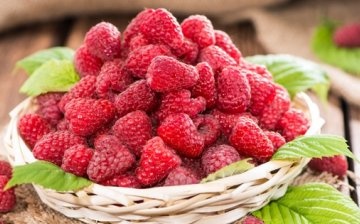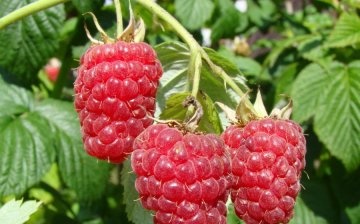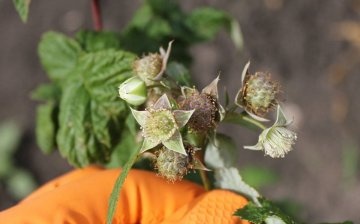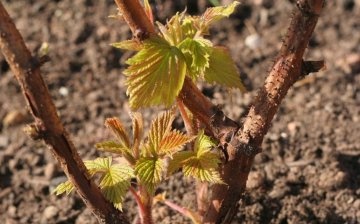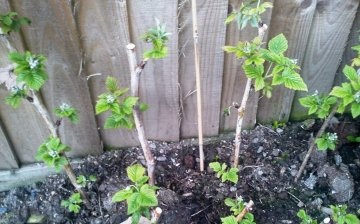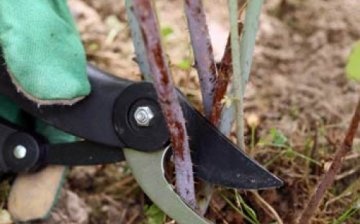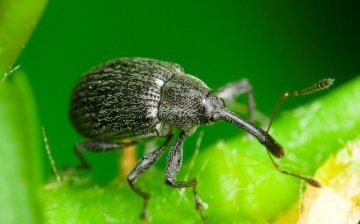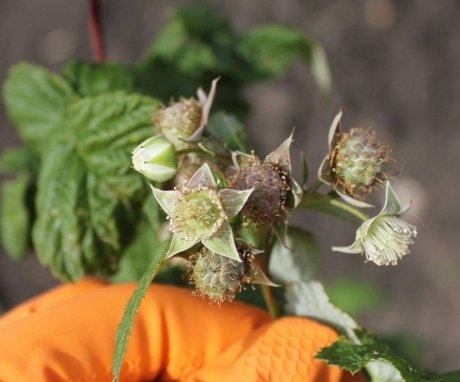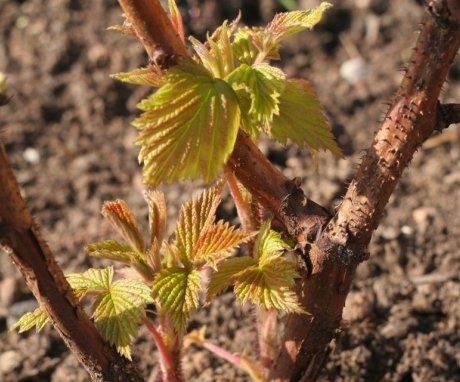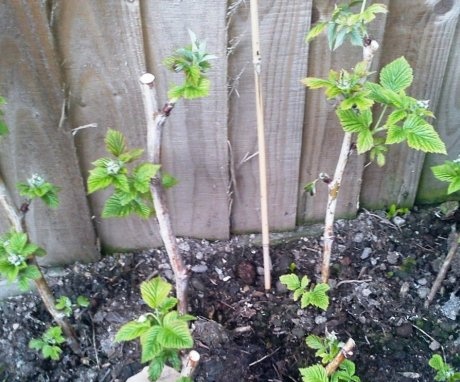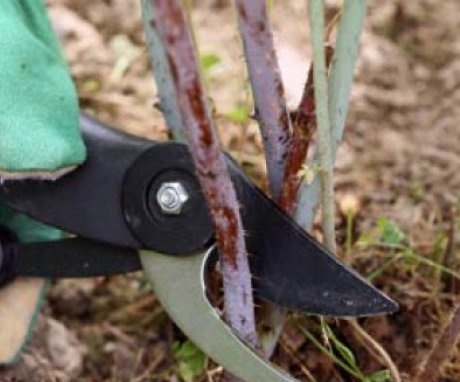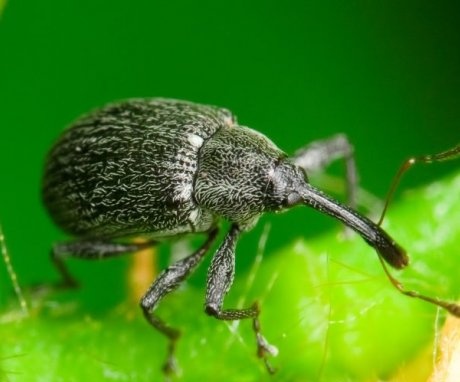Raspberry tree Tarusa: secrets of successful cultivation
Sweet berry raspberries does not leave anyone indifferent. Every year, dozens of varieties of this berry are grown in summer cottages. Not so long ago, breeders bred a standard tree, the fruits of which are raspberries. Such a raspberry tree is gaining more and more popularity every year.
Content:
- Tarusa: description of the raspberry tree
- Raspberry tree care
- Landing rules
- Reproduction of Tarusa
- Pruning secrets
- Diseases and pests
- Application of Tarusa berries
Tarusa: description of the raspberry tree
The Tarusa crimson tree is not a classic tree, in its general presentation. The plant got its name due to the thick erect stems, which outwardly resemble thin tree trunks. The Tarusa variety differs from most of the raspberry species in the absence of thorns. In height, the bushes are extended by 1.5 meters. Young shoots are colored in a light green tone and have a light waxy coating. The leaves are large, heart-shaped, embossed, with pronounced veins. The fruits are a composite drupe, the weight of one berry can reach 16 grams.
The shape of the raspberry berries is oval-elongated, the size is large, the berries are colored red.
The fruit tastes sweet, juicy, and has a delicate flesh. The harvest ripens abundantly, therefore, despite the strong main stem, it is recommended to tie the lateral shoots to pre-stretched trellises or any other supports.
The Tarusa variety is distinguished by high winter hardiness, retains the ability to bear fruit after cold weather down to -30 degrees. Therefore, this view raspberries recommended for growing not only in warm, but also in cold regions with frosty winters. Also, the variety has a high resistance to diseases. Even during illness harvest kept in the same amount.
Tarusa raspberry care
Raspberries are recommended to be planted in well-lit places. Where groundwater does not come out and moisture does not accumulate after irrigation. The place must be protected from wind and draft. The soil in the chosen location should be fertile, loose and well-drained. Before planting seedlings, it is recommended to add lime to acidified soil to reduce acidity.
Gardeners recommend planting raspberries separately, preferably on the south side of the fence or at home at a distance of 1 meter from each other and from the wall. You can choose a site on the border of a vegetable garden or garden, where there will be enough sunlight and heat, and the adjacent plantings will not interfere and infect with parasites. Plant potatoes, strawberries, strawberries and tomatoes recommended at a great distance from raspberries, as they have a common pests... Also, raspberry bushes are not recommended to be planted between fruit trees, since their shade will not allow sufficient sunlight to fall on the leaves and fruits. This will lead to a low yield and weakening of the branches and root system of the plant. In addition, numerous shoots will make it difficult to care for trees.
Raspberry is a moisture-loving plant, but it does not tolerate constant water stagnation and waterlogging of the soil.
Its development slows down significantly, the roots begin to rot, and the whole bush... Therefore, before planting, you can make a semblance of an embankment so that the plant grows and develops on a hill or make outflow channels for excess moisture.
Spring raspberry care:
- It consists in feeding it with wood ash.
- After that, the soil must be loosened and watered well.
- Also gardeners recommend mulch ridges with humus or compost.
- After a while, the first spring leaves will appear on the plant, at this time the bushes must be treated with a weak solution of Bordeaux liquid.
It is regularly necessary to remove the growth, which actively breaks through throughout the season around the mature bushes. It is recommended to carry out this operation with a shovel, cutting off the shoots underground by 7-10 cm.
Raspberries a moisture-loving plant, so it must be watered regularly and abundantly, especially during periods of constant heat and drought. Enhance watering while pouring and seeing the berries. After the spring feeding raspberry bushes can be fertilized with organic matter before and after flowering. Also added mineral fertilizers.
Landing rules
It is recommended to plant large varieties of raspberries in rows in trenches. This requires:
- Prepare a long recess, the size of which should be 1.5 meters long by 30 cm deep.
- Peat, sawdust, compost, humus are laid out on the bottom of the pit. Each layer must be sprinkled with earth. This mixture provides additional nutrition for the planted young bushes.
- Planting of seedlings is carried out in the spring and autumn.
- Before that, all the seedlings must be cut 40 cm in height, after which the roots must be buried, sprinkled with fertile soil and watered well.
- It is recommended to mulch to retain moisture seedlings humus, compost or a good layer of sawdust.
- There should be a distance of at least 80 cm between adjacent bushes, 1.5-2 meters between rows.
After planting, it is necessary to regularly water the young bushes and add organic and mineral fertilizers... The old branch is completely cut and removed only after the young shoots have reached a height of 25 cm.
Reproduction of Tarusa
The Tarusa raspberry tree can be propagated by root cuttings and undergrowth. Root cuttings are used then, when the bushes beat off a small number of children. For this:
- An adult bush is dug in and roots with buds are selected.
- Of them are cut cuttings so that each one has at least 1-2 good healthy kidneys.
- Rooting and germination of such roots is carried out in boxes filled with peat and river sand in equal proportions.
- Cuttings are planted and placed in a warm, well-lit place for further development.
- After a while, sprouts will begin to break through from the soil, when the raspberries take root well, young bushes can be planted in fertile soil in separate containers, excellent seedlings will be ready next year.
Propagation by root shoots is the simplest and most common way. In this case, it is necessary:
- Dig up the sprouts that have formed around the bush raspberries, so that a small piece of the root remains on each young bush.
- Such seedlings are planted in prepared beds, fertilized, watered and mulched.
- If an adult shrub does not produce enough growth, it can be stimulated. For this, the main central part of all shoots is cut to the ground. After a while, sprouts will begin to appear.
Pruning secrets
The raspberry tree needs regular pruning and bush formation... The first step in this process is pinching the top of the main shoot in the year the bush is planted.
Pruning is carried out in May, so that lateral shoots ripen and grow in the leaf axils during the season.
The next year, pinch the tops of these shoots. Strong branching will go, which must be pruned by autumn so that they have time to ripen. A rich harvest will ripen on these branches next year.Pruning the Tarusa raspberry tree is an important process that needs special attention every year.
Diseases and pests
The Tarusa crimson tree is susceptible to attack by various pests and prone to diseases... It is recommended to treat branches and leaves with special preparations in the spring to prevent various ailments.
One of the pests of raspberries is the raspberry beetle, which feeds on the leaves and fruits of the plant.
Its larvae develop in the soil, so it is recommended to regularly loosen it around the bushes, thereby destroying some of the pests. Also, during budding, all raspberry bushes are treated with directional insecticides.
If raspberry bushes are planted in the wrong place, this will be visible by white or yellow spots on the surface of young leaves. This occurs with a lack of water or, conversely, with waterlogging and waterlogging of the soil. In this case, it is recommended to completely transfer the plantings to a more suitable place.
Application of Tarusa berries
Raspberries have many beneficial properties. A large amount of vitamin C, glucose, minerals, fructose has found its application in folk medicine. Raspberries are used in food both raw and in the form of jam, jelly and compotes. Raspberry extract is used in medicine and cosmetology.
Raspberry fruits and leaves are used for colds and for the treatment of intestinal ailments.
It is recommended to be consumed during pregnancy. The great advantage of the fruits and leaves of this plant is that after heat treatment, the medicinal properties are not lost.
Raspberries are harvested for the winter in several simple ways. Berries of the Tarusa variety are well transported, therefore, after harvesting in the country, it can be transported home easily and without damage. The fruits are placed in plastic containers, plastic bags and frozen in the freezer. Also, if you have a dehydrator, the berries can be dried and stored in glass jars. It is good to make tea from such fruits.
The classic and familiar way of harvesting fruits raspberries - this is jam. You can grind the fruits with sugar and, without boiling, pour into jars and store in the refrigerator. Such jam retains a fresh taste, but is stored for 3-4 months. You can also boil raspberries with different amounts of sugar, resulting in jam, jam or compote.
More information on how to crop raspberries can be found in the video.



